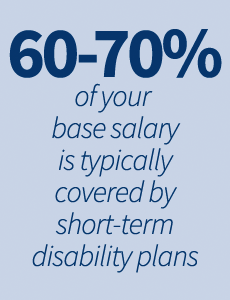How does it actually work?
Disability insurance coverage replaces a portion of your income when you can’t work for a short or extended period of time because of an illness, injury, or pregnancy.
Approximately half of U.S. workers in private industry have disability coverage included in their employee benefits1, with at least part of the cost paid for by their employer. The other half can purchase coverage on an individual basis or through a voluntary benefits plan in the workplace.

Here are the main types of disability insurance and how they work:
Short-term disability insurance (STD) plans usually protect your income for between three days and six months — although some policies offer coverage for up to two years. Short-term plans typically replace between 60 and 70 percent of your pay, depending on the policy. When you choose a plan, be aware of the waiting period, also known as the elimination period. This is the time between you being diagnosed with an illness, injury or having a baby, and the payments kicking in.
Long-term disability insurance (LTD) protects your income if you need to miss work for longer than three to six months. It usually covers 40 to 70 percent of your income. The time your coverage pays benefits will range depending on your policy. It can be for a specific period — ranging from two to five or ten years — or until your Social Security retirement age. The waiting period for most LTD policies is three or six months — so you’ll need a plan to cover costs before the payments begin (usually this time is covered by your STD plan or your savings.) If your employer pays your STD or LTD premiums, your benefits are taxed.
Types of Policies: STD and LTD are typically offered in three ways:
1) Employer-paid plans: These are paid for entirely by your employer.
2) Worksite or voluntary plans: As the employee, you pay the premium. However you can tap into more affordable rates this way. You can also take these policies with you when you change jobs.
3) Individual plans: These are purchased to give you the best possible income insurance, or to a supplement a plan you already have through your job or via a membership organization such as the National Education Association (if you work in education). If you collect benefits under an individual plan, your income is tax-free so your monthly payments will be that much higher. To learn more about individual disability insurance, talk to one of our member companies.
Social Security Disability Insurance (SSDI): The Social Security Administration provides Social Security disability benefits for eligible individuals who have a disability that lasts for one year or longer. Many applicants are denied due to a lack of work history, lack of medical evidence, the temporary nature of their condition, or the fact that people may still be able to work outside of their profession.
The average SSDI benefit in January 2018 was $1,197 a month.2 It generally takes three to five months from time of application to get an initial decision3. Approximately one third of claimants are approved: 20 to 25 percent at the initial application stage, and the remainder after a reconsideration or appeals process.4 In 2017, there was a backlog of more than a million appeals cases, and the associated processing time averaged 18 months.5 More info: www.ssa.gov.
There are also other income-protection products such as critical illness, accident, and medical supplement plans. For more information on these, talk to our member companies.
- Bureau of Labor Statistics, Unpublished estimates, National Compensation Survey, “Access to disability benefit combinations, by occupation group, private industry workers, March 2017”.
- Social Security Administration, Monthly Statistical Snapshot, January 2018.
- Social Security Division Administration, What You Should Know Before You Apply for Social Security Disability Benefits.
- Social Security Division Administration, Annual Statistical Report on the Social Security Disability Insurance Program, 2016, Outcomes of Applications for Disability Benefits, Chart 11.
- Allsup, State-by-State Disability Backlog, 2017.
- Integrated Benefits Institute, Health and Productivity Benchmarking 2016 (released November 2017), Short-Term Disability, All Employers. Condition-specific results.
- Integrated Benefits Institute, Health and Productivity Benchmarking 2016 (released November 2017), Long-Term Disability, All Employers. Condition-specific results.

“What are the most common
causes of disability claims?”
The most common diagnostic categories for short-term disability claims include:6
- Pregnancies (25 percent)
- Conditions affecting the back and spine, knees, hips, shoulders, and other parts of the body — collectively referred to as musculoskeletal disorders (20 percent)
- Digestive disorders, such as hernias and gastritis (7.8 percent)
- Mental health issues including depression and anxiety (7.7 percent)
- Injuries such as fractures, sprains, and strains of muscles and ligaments (7.5 percent)
The most common diagnostic categories for long-term disability include musculoskeletal disorders (29 percent) and cancer (15 percent).7


